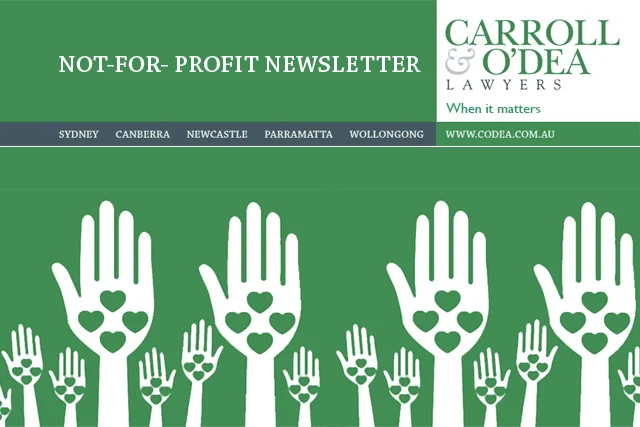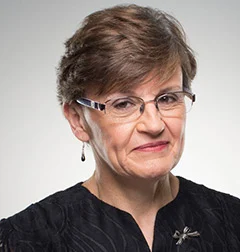
Not-For-Profit Newsletter – April 2013
Published on April 26, 2013 by Josephine Heesh and Patricia Monemvasitis
Helping you navigate the changing not-for-profit regulatory landscape
Welcome to the April edition of the Carroll & O’Dea Not-For-Profit newsletter. This month, we take a look at the Charities Bill 2013, which proposes a new Act to define charity and charitable purpose. We also provide details of governance standards now final, and comments on the draft annual information statement circulated by the Australian Charities and Not-for-profits Commission (ACNC) for discussion. Finally, we bring you some of the latest news stories from the global not-for-profit sector.
If you’d like to discuss how any of the updates in this newsletter affect your organisation, please contact Josephine Heesh jheesh@codea.com.au or 9291 7170
Charities Bill 2013: a new definition for charities
From 1 January 2014, a new definition of charity and charitable purposes will become law. In this article, we’ve included an overview of the draft Bill,.
Until now, the law has defined ‘charity’ and ‘charitable purpose’ based on the four heads mentioned in the Pemsell test, going back to the statute of Elizabeth (I): ‘relief of poverty, advancement of education, advancement of religion and other purposes beneficial to the community’.
The Charities Bill 2013 preserves the four traditional common law heads and expands those general heads. It defines the following charitable purposes:
a. advancing health
b. advancing education
c. advancing social or public welfare (which includes the purpose of relieving poverty and caring for children and young people, as well as disaster relief by charitable entities)
d. advancing religion
e. advancing culture
f. promoting reconciliation, mutual respect and tolerance between groups of individuals that are in Australia
g. promoting or protecting human rights
h. protecting the safety of the general public
i. preventing or relieving the suffering of animals
j. advancing the natural environment
k. any purpose analogous or within the spirit of those above
l. promoting or opposing change to any matter established by law, policy or practice of the Commonwealth, state or territory or another country if:
i. the change is in furtherance or in aid of (a)–(k) above; or
ii. the change is in opposition to or in hindrance of (a)–(k) above.
Mark Butler, Minister for Social Inclusion, and David Bradbury, Assistant Treasurer, released the exposure draft of Charities Bill 2013 on 7 April 2013 to ‘define charity and charitable purposes and for related purposes’. The Bill is the culmination of consultation on a discussion paper issued back in 2011.
What are the key changes?
All charities must be “ not-for-profit” (which definition itself is the subject of legislation still before the Parliament) but not have any disqualifying purpose.
Political lobbying, which has always been disqualified as a charitable purpose, is now allowed if it promotes or opposes change to law, policy or practice, which is in furtherance of, or opposition to, another charitable purpose.. Paragraph (l) in the Bill endorses the decision in the Aid/Watch Case (2010) in which the High Court upheld Aid/Watch’s charitable status and its right to engage in political debate.
Importantly, the Bill preserves the public benefit presumption, which has always attached to the three heads (poverty, education and religion). Relieving illness and the needs of the aged are also presumed for the public benefit.
A number of previously ineligible entity types now qualify for charitable status, including:
– charitable funds which distribute to government entities, provided but for their character as government entities, those entities would otherwise be “charities” Indigenous groups receiving a native title benefit, even thoughmembers are related to one another, no longer disqualified from meeting “the public benefit’ test
– open and non-discriminatory self-help groups, provided they meet certain criteria
– closed or contemplative religious orders, so long as they regularly undertake prayerful intervention at the request of members of the general public. Previous special legislation about this will be repealed and included in this legislation.
Other charities must prove that their purpose is ‘for the public benefit’ by establishing that their purpose benefits the general public or a sufficient section of the public, and the benefit is ‘a universal or common good’; that is, it provides real overall value to the public. The Bill introduces a comparison of how many people benefit with how many people the charity’s purpose relates to.
Any ‘benefit’ that accrues to founders, members or their associates will be reviewed, as will any detriment to the general public that may flow from the entity’s purpose.
ACNC update:
Annual information statements
From the 2013 reporting period, all charities must provide annual information statements (AISs). Recently the ACNC published a sample 2013 AIS (link) and gave the public an opportunity to make comments. There is also a step-by-step guide to the sample (link), which will be updated once the 2013 AIS is finalised. The consultation period will close on 26 April 2013. The ACNC will release the final AIS shortly. We will comment on any significant changes to the final AIS once it has been issued.
Reporting requirements vary depending on the size of the charity. Small charities (with annual revenue less than $250,000) do not need to provide as much information as medium or large charities (with annual revenue of $250,000 or more).
As well as submitting an AIS, charities will need to include additional information, which varies depending on the size of the charity. It includes certain financial information, which will be in addition to the separate annual financial reports that medium and large charities must lodge from June 2014. Charities should ensure that the financial details in their AIS and financial report are consistent.
Basic religious charities do not need to provide any financial information, but will need to identify whether they are small, medium or large.
Governance standards under the ACNC Act
In Carroll & O’Dea’s February 2013 newsletter (published on 13 February), we summarised the next stage of ACNC’s anticipated reforms, which would focus on governance standards. Entities have until 1 July 2017 to modify their constitutions to meet these governance standards. The Standards do not apply to basic religious charities but are now formalised as follows:
Standard 1: Object
To ensure the charity achieves its purposes, this standard states (in summary):
‘A registered entity must be able to demonstrate by reference to its governing rule that its purposes and character are not-for-profit and it must make information available to members, donors, employees, volunteers and benefit recipients about its purposes.’
See below for Carroll & O’Dea’s commentary on two recent UK charity matters where ‘purposes’ were considered by the Charities Commission.
Standard 2: Accountability to members
To ensure transparency, this standard states (in summary):
‘An entity must take reasonable steps to ensure it is accountable to its members and they have an adequate opportunity to raise concerns about governance.’
Standard 3: Obliges an entity to comply with Australian law
The objective of Standard 3 is to ensure the public has trust and confidence concerning the entity’s operations, and to ensure the safety of entities’ assets. It states (in summary) that Standard 3:
‘… is expressed to require an entity not to engage in conduct or omission that may be dealt with as an indictable offence under an Australian law or by way of a civil penalty of 60 penalty units or more.’
Standard 4: Suitability of responsible entity
The objective of Standard 4 is to maintain and enhance public trust and confidence. It states (in summary):
‘An entity must take reasonable steps to ensure each of its responsible persons are not disqualified from managing a company, not disqualified by the Charities Commissioner from being a responsible entity or if unsatisfied about a person, removes that person from a position of responsibility.’
Standard 5: Duties of responsible entity
The objective of Standard 5 is to ensure entities conduct themselves responsibly, so the public has confidence that entities are actively working to prevent non‑compliance. In summary, it states:
‘A registered entity must take reasonable steps to ensure responsible entities (i.e. its directors/board/committee members):
a. comply with their duties with the degree of care and diligence that a reasonable individual would exercise;
b. act in good faith;
c. don’t misuse their position;
d. don’t misuse information;
e. disclose perceived or actual material conflicts of interest;
f. ensure the entity’s financial affairs are managed in a responsible manner; and
g. do not allow the entity to operate while insolvent.’
Standard 5 includes a number of protections that are a defence against breaches of Standard 5 This table (link) contains a checklist to match protections against breaches of Standard 5.
If your organisation’s constitution is incorporated under a state or territory law, it is deemed to meet Standard 5, but only until 1 July 2017. It is anticipated that state incorporated association laws may adopt Standard 5 before that time. In fact, South Australia and ACT have already done so.
Under Standard 4, the ACNC will have the power to disqualify people responsible for an entity not meeting these governance standards. The names of disqualified responsible persons will be entered on a public register maintained by the ACNC Commissioner.
Standard 1:
Is a charity still performing ‘charitable purposes’? Recent UK examples
The Prayer Book Society
In 2012, the Prayer Book Society approached the United Kingdom Charities Commission for consent to amend the objects clause of its memorandum of association, if its members voted to do so.
The Prayer Book Society informed the Commission that it intended to undertake a number of new activities closely related to its existing activities. Rather than amend the Society’s objects to include these new activities, it decided to simplify them.
The Commissiongranted consent under section 198(1) of the UK Charities Act 2011. The decision was appealed by a member of the charity on the grounds that the Prayer Book Society’s core object – to promote the Book of Common Prayer in principal services of the Church of England and other Anglican Churches – would be altered, as the revised object would allow the charity to promote other forms of service.
The Commission concluded that the consent to the change of objects was lawful and within the Commission’s scope. It found the proposed change did not alter the foundation of the charity and it disagreed with the member’s analysis of the existing object of the charity.
For Australian charities, this case might be sighted to persuade ACNC to consent to a change of objects.
The Gilstrap Charity
On 5 March 2013, the United Kingdom Charities Commission reviewed a proposed scheme to amend the objects of the Gilstrap Charity. The amendment would allow the trustees to either sell or lease the Gilstrap Building, and provide for how the proceeds of the sale would be used.
In 1883, the Gilstrap Building was gifted as a public library to the people of Newark by William Gilstrap. Due to investment income being insufficient to maintain and repair the building, the trustee (Newark and Sherwood District Council) proposed to lease the property. The trustee argued that money from leasing the building would be better used for the Gilstrap Charity’s purposes, without being tied to a specific building.
The trustee’s proposed amendments would ensure that any future disposal of the property (by lease or sale) could only proceed if the trustee decided that the land was no longer required for use in furtherance of the charity’s objects. The decision to dispose of the property would have to be confirmed by consultation with the inhabitants of the area.
The Commission held the proposed scheme to be valid. It found that a charity may only make a scheme to change its purpose in certain circumstances (known as the ‘cy-pres principles’). The Commission concluded that a ‘cy-pres occasion’ had arisen and that in the circumstances, the proposed scheme was an appropriate cy-pres application.
For Australian charities, the case could be cited in a Supreme Court cy pres application, if the facts were relevant to the local charity.
Royal Commission into child sexual abuse begins
The Royal Commission held its first public sitting on 3 April 2013, during which the Chair Justice Peter McClellan explained the operating model that the Commission would use. The one-hour hearing was broadcast online. There was no opportunity for submissions from the bar table, but the senior counsel assisting the Commission, NSW barrister Gail Furness SC, set out in detail how the Commission would conduct evidence gathering, including announcing legal assistance for victims who wished to tell their stories. Read the full transcript.
The Catholic Church’s Truth, Justice and Healing Council issued a media statement in response to the first day’s sitting. It said it would not stop victims from telling their stories to the Commission because of past confidentiality agreements. Read the media release.
In other news…
Is the Pope tweeting?
When Pope Benedict departed the Vatican, billions of people around the world were left with mixed feelings. Tears were shed and anticipation reigned throughout the Vatican as the Christian world welcomed the first ever South American Pontif, Pope Francis.
The Twittersphere was experiencing Pope-mania as many turned to the Pope’s account – @Pontifex – for the latest news. This raised the interesting question of whether the Pope’s handle and content was owned by Pope Benedict himself or by the Papacy as an institution.
Luckily the Vatican had been forward-thinking and retained control over the papal Twitter account. When Francis was elected in March 2013, the Vatican archived Benedict’s tweets, clearing the slate for the incoming Pope. It is uncertain whether Benedict, or Emeritus Pope as he is officially known, will keep up with his tweeting and whether Pope Francis will pursue as rigorous a social media profile.
Given the rapidly changing world of social media, this situation should act as a reminder for organisations to consider their own social media policies. In particular, it’s important to clarify the rules that bind employees and employers, including in relation to ownership of handles, content and contacts.
Livestrong rebuilding its strength
Lance Armstrong’s fall from grace was one of the most public and damaging events a sporting figure has ever faced. Many people across the globe had been inspired by Armstrong’s personal story of grit and determination. Livestrong Foundation, the charity founded by Armstrong to support cancer survivors, became a symbol of hope for many.
Unsurprisingly, Livestrong has undergone a rebranding strategy since the doping allegations dramatically came to light. The charity has adopted a new logo as part of its fresh image and has employed the creativity of trade mark lawyers to assist with the rebranding.
The charity has a long way to go in rebuilding the trust that Armstrong destroyed. With a multi-thronged campaign involving trade mark lawyers, PR aficionados and business heads already in the works, it will be interesting to see the extent to which Livestrong is able to rejuvenate its brand.
Josephine Heesh
Associate
Ph: 02 9291 7170
jheesh@codea.com.au

